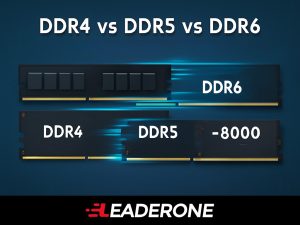
Comparison of DDR4, DDR5, and DDR6 memory modules, showing speed, architecture, and applications differences. Features include 3200 MT/s for DDR4, 4800 MT/s with dual channels for DDR5, and 8800 MT/s with quad sub-channel for DDR6.
The world of computing is in a constant state of evolution. At the heart of every system lies memory, and the ongoing transition from one generation to the next is a critical benchmark for performance. The comparison between DDR4 vs DDR5 vs DDR6 reveals a clear trajectory of increasing speed, efficiency, and architectural innovation. While DDR4 is still common in many systems, DDR5 is the current standard, and DDR6 is now in the early stages of development, promising to double the speed of its predecessor.
DDR4: The Dependable Predecessor
DDR4 (Double Data Rate 4) was the memory standard for over a decade. It introduced significant improvements over DDR3, including higher speeds and lower voltage.
- Speed: DDR4 offered data rates from 2133 MT/s up to 3200 MT/s, with some high-end modules reaching even faster speeds.
- Architecture: It used a single 64-bit channel per memory module.
- Voltage: Operating at 1.2V, it was more power-efficient than DDR3.
- Applications: Today, DDR4 remains a cost-effective choice for older and budget-friendly systems, including many laptops and desktop PCs. Its lower cost and maturity make it a practical option for many.
DDR5: The Current Market Standard
DDR5 represents a substantial leap forward, not just in speed, but in fundamental architecture. Introduced in 2020, DDR5 has now become the standard for new platforms, especially those running Intel’s 12th Gen Core series and newer, as well as AMD’s Ryzen 7000 series and beyond.
- Speed: DDR5 starts at 4800 MT/s, already a 50% increase over DDR4’s typical top speed. Speeds are expected to reach up to 8800 MT/s as the technology matures.
- Architecture: The biggest change is its dual 32-bit sub-channel architecture per module. This effectively doubles the memory bandwidth and improves efficiency. DDR5 also moved voltage regulation onto the module itself with a Power Management IC (PMIC), which enhances stability and signal integrity.
- Voltage: It operates at an even lower 1.1V, offering better power efficiency despite the significant speed increase.
- Applications: DDR5 is the ideal choice for modern high-end gaming rigs, professional workstations, and enterprise data centers where its increased bandwidth is critical for handling multi-core CPUs and large datasets.
DDR6: The Future of Memory Performance
The race to the next generation is already underway. While still in development, the specifications for DDR6 memory are beginning to take shape, promising an even more dramatic performance jump than the transition from DDR4 to DDR5.
- Speed: Early projections suggest DDR6 will start at 8800 MT/s, with top-end speeds potentially reaching up to 17,600 MT/s. This would effectively double the top speed of DDR5 and quadruple the speed of DDR4.
- Architecture: DDR6 is expected to feature a quad sub-channel architecture, further enhancing parallelism. This will allow for massive memory bandwidth and lower latency.
- Voltage & Power: The new standard will continue the trend of lower voltage, operating at less than 1.1V. This focus on power efficiency is crucial for meeting sustainability goals in future data centers and for the next generation of mobile devices.
- Applications: The incredible performance of DDR6 is being designed specifically for the most demanding applications of the future: advanced AI, machine learning, exascale supercomputing, and immersive virtual reality platforms.
Conclusion: Making the Right Choice
The choice between DDR4 vs DDR5 vs DDR6 depends entirely on your needs. For budget-conscious builds, DDR4 still offers great value. For those building or upgrading a new system today, DDR5 is the clear choice, providing significant performance gains and modern architectural features. As for DDR6, its emergence promises to unlock a new era of computing, paving the way for technologies that are currently only in their infancy.
Those channels can obtain:
